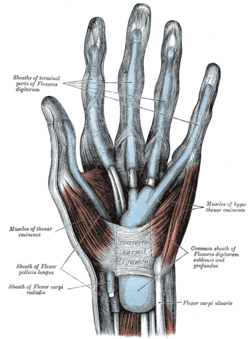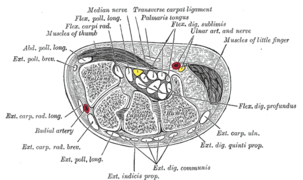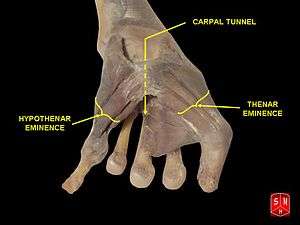Thenar eminence
The thenar eminence refers to the group of muscles on the palm of the human hand at the base of the thumb. The skin overlying this region is the area stimulated when trying to elicit a palmomental reflex. The word thenar comes from Greek θέναρ (thenar), meaning 'palm of the hand'.[1]
| Thenar eminence | |
|---|---|
 | |
 | |
| Details | |
| Artery | Superficial palmar arch |
| Nerve | Median nerve |
| Actions | Control movement of the thumb |
| Identifiers | |
| Latin | Eminentia thenaris |
| TA | A01.2.07.023 |
| FMA | 61520 |
| Anatomical terms of muscle | |
Structure
The following three muscles are considered part of the thenar eminence:[2]
- Abductor pollicis brevis abducts the thumb. This muscle is the most superficial of the thenar group.
- Flexor pollicis brevis, which lies next to the abductor, will flex the thumb, curling it up in the palm.
- Opponens pollicis lies deep to abductor pollicis brevis. As its name suggests it opposes the thumb, bringing it against the fingers. This is a very important movement, as most of human hand dexterity comes from this action.
Another muscle that controls movement of the thumb is adductor pollicis. It lies deeper and more distal to flexor pollicis brevis. Despite its name, its main action is mainly rotation and opposition. It is not in the thenar group of muscles, so is supplied by the ulnar nerve.[3]
Nerve supply
The opponens pollicis and abductor pollicis brevis are normally innervated by the median nerve.
The flexor pollicis brevis has two heads a superficial and a deep. The flexor pollicis brevis (FPB) is typically an ulnar-innervated muscle. Due to a common interconnection between the median and ulnar nerves in the hand (Riche-Cannieu interconnection), the Median nerve may innervate the FPB in 35% of people. It is innervated by the Ulnar nerve in 50% of people and by both the median and ulnar nerves in 15%.
The adductor pollicis is typically innervated by the ulnar nerve. There are normal variations. In a Cannieu-Riche anastomosis, fibers from the deep palmar branch of the ulnar nerve innervate the opponens pollicis and/or abductor pollicis brevis. Regardless of their final innervation, the nerves that reach the thenar muscles arise from the C8 and T1 roots, pass through the lower trunk of the plexus, and then through the medial cord of the plexus.
The ulnar nerve is exclusively responsible for the innervations of the hypothenar eminence. Both nerves contribute to the innervations of the midpalmar group.[4]
The muscles in this location are usually innervated by the recurrent branch of the median nerve. They all control movement of the thumb.
The innervation of these muscles by the median nerve is unusual, as most of the intrinsic muscles on the palm of the hand are supplied by the ulnar nerve. The lateral two lumbrical muscles are the other exception.
Additional images
- Thenar eminence
 Carpal tunnel and thenar and hypothenar eminences
Carpal tunnel and thenar and hypothenar eminences
See also
References
- θέναρ
- "Intrinsic Muscles of the Hand — Wheeless' Textbook of Orthopaedics". Retrieved 2008-01-16.
- "Applied MSK anatomy of the hand". Archived from the original on 2008-01-01. Retrieved 2008-01-16.
- Van De Graaff, Kent M. (1992). Human Anatomy (3rd ed.). Dubuque: Wm C Brown. ISBN 0-697-09716-1. Print.
External links
- lesson5mus&tendonsofhand at The Anatomy Lesson by Wesley Norman (Georgetown University)